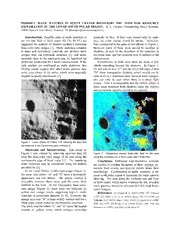
NASA Technical Reports Server (NTRS) 20070014474: Possible Mafic Patches in Scott Crater Highlight the Need for Resource Exploration on the Lunar South Polar Region PDF
Preview NASA Technical Reports Server (NTRS) 20070014474: Possible Mafic Patches in Scott Crater Highlight the Need for Resource Exploration on the Lunar South Polar Region
POSSIBLE MAFIC PATCHES IN SCOTT CRATER HIGHLIGHT THE NEED FOR RESOURCE EXPLORATION IN THE LUNAR SOUTH POLAR REGION. B. L. Cooper, Oceaneering Space Systems, 16665 Space Center Blvd., Houston TX ([email protected]) Introduction: Possible areas of mafic material on gradually to blue. If they were caused only by shad- the rim and floor of Scott crater (82.1ºS, 48.5ºE) are ows, the color change would be abrupt. Moreover, suggested by analysis of shadow-masked Clementine they correspond to the areas of low albedo in Figure 1. false-color-ratio images [1]. Mafic materials common However, parts of these areas should be ascribed to in mare and pyroclastic materials can produce more shadows, as seen by the sharpness of the transition at oxygen than can highlands materials [2], and mafic the crater rims, and the complete lack of features in the materials close to the south pole may be important for darkest areas. propellant production for a future lunar mission. If the Nevertheless, in both cases there are areas of low dark patches are confirmed as mafic materials, this albedo extending beyond the shadows. In Figure 1, finding would suggest that other mafic patches may the left side of area “C” and the lower left edge of area exist, even closer to the poles, which were originally “D” show topographic features, which would not be mapped as purely anorthositic [3]. seen at all in a shadowed area, because lunar topogra- phy can only be seen when there is a direct light source. Thus it is reasonable that the yellow colors in these areas represent both shadows (near the craters) AA and pyroclastic deposits (distal to the craters). BB AA CC BB CC DD DD Figure 1. Lunar Orbiter IV Frame 118, showing the area that corresponds to the Clementine data in Figure 2. Discussion and Interpretation: The image in Figure 2 was created by removing spurious data [4] Figure 2. Clementine mosaic false-color data for the area from the false-color ratio image of an area along the along the northeast rim of Scott crater (82.1ºS,48.5ºE). northeastern edge of Scott crater [1]. The remaining Conclusion: Additional high-resolution analyses color variations may be interpreted using the method are needed to confirm the nature of these patches, de- provided by [5]. termine their extent, and provide details about their In the Lunar Orbiter visible-light image (Figure 1), morphology. Confirmation of mafic materials in the the areas near letters “A” and “B” have a hummocky lunar south polar region is important for lunar mission appearance and low albedo. The albedo contrast is planning. The area along the northeast rim and floor noticeable between these areas and the crater floor of Scott crater, which shows evidence for drk, possibly material to the west. In the Clementine false-color- mafic patches, should be selected for LRO High Reso- ratio image (Figure 2), these areas are indicated by lution Imagery. yellow and orange pixels, suggesting high-Ti mafic References: [1] Cooper B. L. (2007) LPSC 38th, Abstract materials or pyroclastic deposits [5, 6]. However, the #1377. [2] Allen, C. C. et al. (1994), Space ’94, 1157-1166. [3] orange area near “B” is more solidly colored and has a Wilhelms et al. (1979), Map I–1162, USGS. [4] Lucey et al. (1998) sharp edge, which makes its interpretation uncertain. JGR, 103, 3679. [5] Pieters et al. (1994) Science, 266, 1844. [6] The areas near the letters “C” and “D” show the largest Farrand et al. (1999), New Views of the Moon II. amount of yellow color, which changes somewhat
